EXTEND & PRETEND: Shifting Risk to the Innocent
Stock-Markets / Financial Crash May 07, 2010 - 01:01 AM GMTBy: Gordon_T_Long
 Markets never repeat themselves but they often rhyme. This rally feels like the same sonnet we experienced in 1987. As in a sonnet, it is following a strict rhyme scheme and specific structure.
Markets never repeat themselves but they often rhyme. This rally feels like the same sonnet we experienced in 1987. As in a sonnet, it is following a strict rhyme scheme and specific structure.
In 1987 the rally began gaining steam in the spring when it already seemed overbought and extended. The rally had initially started in October 1986 at DOW 1400, but during the spring of 1987 it began to accelerate. It not only didn’t correct, but continued to gain momentum. Despite all the pundits saying it was about to correct, it just kept going up. By early fall the bears had capitulated and the public was scrambling to avoid missing further gains. They were quickly rewarded as the market moved even higher. No bad news, overextended fundamentals or technical warnings could stop the rise. The DOW was soon over 2700 for an approximate 93% rise.
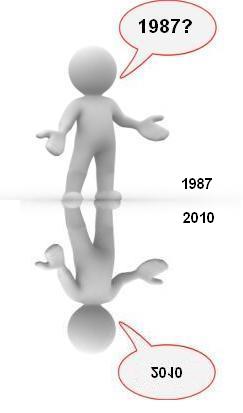 Then suddenly in October 1987, out of nowhere, the crash hit. It was stunning. The market gave back 22.6% in one day. What was later called Black Monday left a pale over the US that was palpable. In a matter of days the market surrendered the entire gains it had achieved over the previous year.
Then suddenly in October 1987, out of nowhere, the crash hit. It was stunning. The market gave back 22.6% in one day. What was later called Black Monday left a pale over the US that was palpable. In a matter of days the market surrendered the entire gains it had achieved over the previous year.
Before you write me off too quickly as trying to draw too close a comparison, let me tell you why it really feels the same. It isn’t just the rise or rhyme; it’s the reason for both.
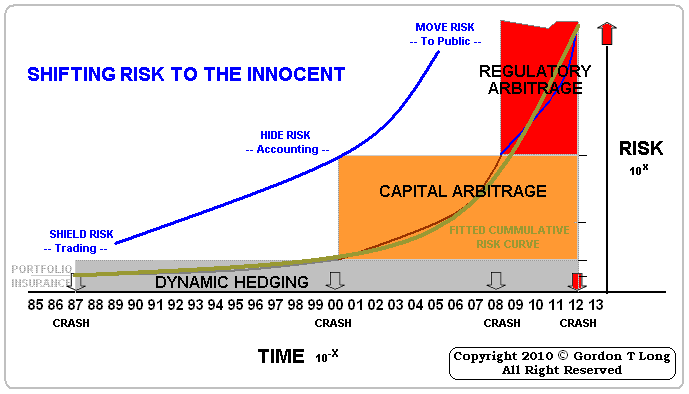
Since March 2009 the current rally has moved from a 666 low on the S & P 500 to a recent high of 1220, for an 83% increase in just over a year. The rises are similar to 1987 but so are the critical elements of risk and how risk has been shifted to the innocent. Before I discuss how this risk has shifted through Dynamic Hedging, Capital Arbitrage and Regulatory Arbitrage, let me first briefly talk about the realities of risk versus perceptions.
REALITIES OF RISK
USING STATISTICS TO SHOW US HOW THE INNOCENT GET LULLED INTO GETTING 'MUGGED'!
Let's say there's a statistically unlikely event that takes place 1% of the time. As an example, suppose, just for argument's sake, that if you go for a walk in a particular Chicago neighborhood, statistically the police tell you, 1% of the time you will get mugged in this neighborhood.
So, if you go out for a walk one time, you have a 99% chance of not getting mugged and a 1% chance of getting hurt. But suppose you go out for one walk every day for 10 days, the chance that you will get hit on one of those occasions rises. The way it's calculated is by figuring the odds that the LIKELY event will obtain at every single iteration and then subtracting that from 100%. The equation is:
 D = 1-(1-P)^N
D = 1-(1-P)^N
Where:
D=cumulative percentage chance of disaster P= Percentage Chance of disaster on each opportunity (iteration) N=number of iterations
So, if you go out for 10 walks, your chance of getting into trouble is:
1-(1-.01)^10 = 9.6%.
And if you go out for a walk every day for, say, 90 days, your chance of getting hurt is
1-(1-.01)^90 = 59.5%.
The graph above shows what the series looks like. (1)
And in this scenario, if you go out for a walk every trading day of the year (about 252 times) the odds are about 92% that you will meet your demise.
But the funny thing about our human nature is that if, say, you went out for 252 walks in our Chicago neighborhood and came back 252 times, without having had any violent encounters with our Chicago’s city folk, you would assume that experience was teaching you that there was very little danger. Indeed it might be, if you didn't already know the likelihood of getting mugged.
As human beings we are especially primed to generalize from experience (that's science), but most especially to generalize from our most recent experiences (which is less reliable science--or anecdotal evidence). So, the more walks we go on without getting mugged the less likely we FEEL it to be that we will ever get mugged, irrespective of what statistics might tell us. As our risk increases, statistically speaking, we feel safer and safer.

We are all familiar with the expression "tempting fate." One has to wonder if we might be somewhere fairly far along on the curve charted above, feeling safer and safer carrying all these economic loads, but with an ever greater and greater chance of developing the incidence of one or another severe, "dislocating," and "unlikely" event. (1)
LAW OF COMPOUNDING NUMBERS
20% Gains for 3 years then a 20% loss results in = 8.4% CAGR
20% Gains for 3 years then a 35% loss results in = 2.9% CAGR
See the illusion?
Our government is doing us no favors with an artificial extend and pretend strategy that makes us feel safer and which consequentially starts the public spending and investing again. Based on risk, it is both premature and dangerous to your financial health.
DYNAMIC HEDGING
PORTFOLIO INSURANCE
 When the investigations were made by the government into the causes of the 1987 crash, it was discovered that it was primarily because of the wide implementation of what was then called Portfolio Insurance. It was the rage in the late 80’s as a way of removing risk from portfolios. At its core, Portfolio Insurance involved trend following methodologies. Consequentially, the more stocks moved up, the more your portfolio called for more buying. It was self re-enforcing. It also worked in reverse and consequentially the sudden crash. The investigations prompted the introduction of circuit breakers into exchanges to limit downside moves in any given period of time.
When the investigations were made by the government into the causes of the 1987 crash, it was discovered that it was primarily because of the wide implementation of what was then called Portfolio Insurance. It was the rage in the late 80’s as a way of removing risk from portfolios. At its core, Portfolio Insurance involved trend following methodologies. Consequentially, the more stocks moved up, the more your portfolio called for more buying. It was self re-enforcing. It also worked in reverse and consequentially the sudden crash. The investigations prompted the introduction of circuit breakers into exchanges to limit downside moves in any given period of time.
SON-OF-PORTFOLIO INSURANCE
Though Portfolio lost its appeal after the 1987 crash, it was replaced by what many at the time referred to as the son-of-portfolio insurance. It was called Dynamic Hedging.
Dynamic hedging is a technique that is widely used by derivatives dealers to hedge gamma or vega exposures. Because it involves adjusting a hedge as the underlier moves—often several times a day—it is "dynamic. Dynamic hedging is delta hedging of a non-linear position with linear instruments like spot positions, futures or forwards.  The deltas of the non-linear position and linear hedge position offset, yielding a zero delta overall. However, as the underlier's value moves up or down, the delta of the non-linear position changes while that of the linear hedge does not. The deltas no longer offset, so the linear hedge has to be adjusted (increased or decreased) to restore the delta hedge. This continual adjusting of the linear position to maintain a delta hedge is called dynamic hedging. (2)
The deltas of the non-linear position and linear hedge position offset, yielding a zero delta overall. However, as the underlier's value moves up or down, the delta of the non-linear position changes while that of the linear hedge does not. The deltas no longer offset, so the linear hedge has to be adjusted (increased or decreased) to restore the delta hedge. This continual adjusting of the linear position to maintain a delta hedge is called dynamic hedging. (2)
Dynamic Hedging was a major contributor to the tech bubble run-up in the late 1990’s, the 2002-2007 run-ups and the present rally. It is one of the reasons this rally feels so similar and is being driven for similar reasons. But there is more.
The risks are even greater today because Dynamic Hedging has allowed other advancements to be layered on top of it.
With the post tech bubble crash in 2000 and the subsequent advent of the housing bubble explosion from 2002 to 2007 we saw the emergence of Capital Arbitrage.
CAPITAL ARBITRAGE
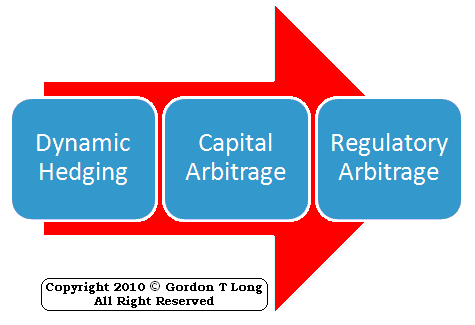 I am defining Capital Arbitrage here (as opposed to the slightly different Regulatory Arbitrage) as the price difference in the cost of capital through the reduction of risk via various methods including removing debt obligations (risk) from the balance sheet. The price difference incapital costs is reflected in a lower interest coupon or basis point spread.
I am defining Capital Arbitrage here (as opposed to the slightly different Regulatory Arbitrage) as the price difference in the cost of capital through the reduction of risk via various methods including removing debt obligations (risk) from the balance sheet. The price difference incapital costs is reflected in a lower interest coupon or basis point spread.
The advancements in securitization and financial engineering have allowed this to happen in a dramatic fashion over the last decade. Consequentially, the ability to extend credit prior to the financial crisis was almost exponential in its growth - all of which was hedged through Dynamic Hedging and through newer techniques such as Credit Default Swaps (CDS). Capital arbitrage fostered yet another bubble until the reversal once again happened and we had the expected explosive momentum to the downside.
The table below is a simplified summary of a lot of the work outlined in recent Extend & Pretend series articles and the Sultans of Swap series. It illustrates that almost all forms of standard accounting practices & procedures have been circumvented through modern Capital Arbitrage techniques. Whether Corporate accounting with its cost /accrual structure, Financial and bank accounting with its reserve and capital ratios or Government accounting with its cash account accounting, it doesn’t matter, they have all been systematically exploited.
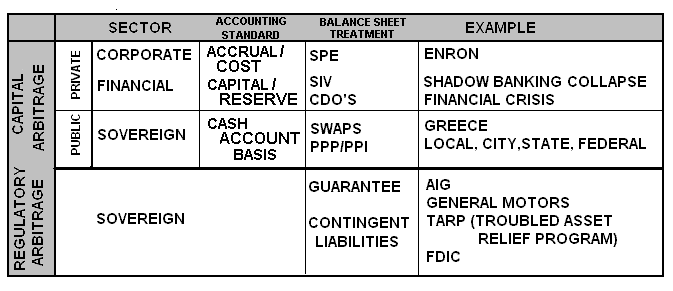
There is only one goal, obscure debt or financial obligations, commitments, guarantees or contingent liabilities. This is to allow an improvement or maintenance in the cost of capital and thereby allow further increases and gearing (leverage).
REGULATORY ARBITRAGE
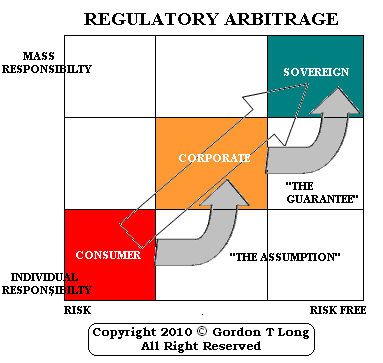 Today we have layered yet another layer of risk onto the already existing structure. It is called Regulatory Arbitrage.
Today we have layered yet another layer of risk onto the already existing structure. It is called Regulatory Arbitrage.
Regulatory arbitrage is any transaction that has little or no economic impact on a financial institution while either increasing its capital or decreasing its required capital. Just as trading arbitrage identifies and exploits inconsistencies in market prices, regulatory arbitrage identifies and exploits inconsistencies in capital regulations. Regulatory arbitrage undermines the effectiveness of capital regulations. It is one of the primary motivators for regulators to continually improve capital requirements. (3)
This new strategy is again intended to remove risks but in this case you are transferring it to a sovereign government in a number of fashions. Whether debt or contingent liability obligations, the strategy involves the sovereign government assuming responsibility and being forced to create the credit to further the arbitrage.
It is highly sophisticated with many elements but like the previous stages, it will end badly and likely violently. This time the probability is that it ends when sovereign governments fail or are unable to attract investors at satisfactory rates (i.e. Greece now having to pay over 9% on 10 Year Treasuries versus an expected 3.5%). Credit rating downgrades and forced increases in collateral calls will be the catalyst. We are now seeing just the tip of this iceberg throughout the southern European countries (PIIGS).
‘TOO BIG TO FAIL or are they TOO BIG TO SAVE?
We have ‘saved’ the following by the public assuming the liabilities after all the profits were earned and distributed.
1. Fannie Mae / Freddie Mac Agencies 1.5 - 2+T
2. AIG 180B
3. GM / GMAC 45B
4. TARP – Banks 700B
5. FDIC – Regional Banks ??
===
~ $3 Trillion
CONCLUSION
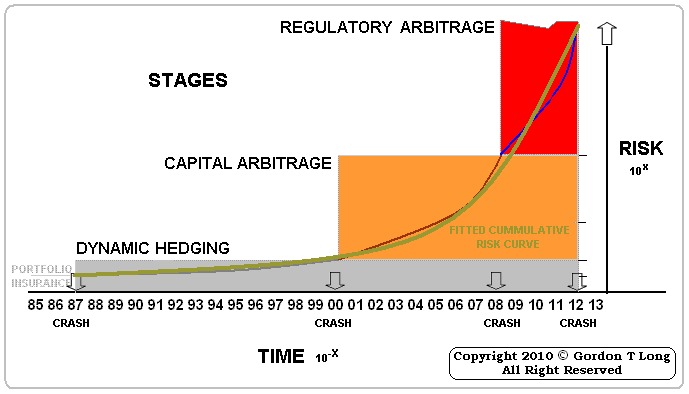
When markets stop functioning any algorithm breaks down. Trading algorithms are based on certain fundamental assumptions that have proven invalid over long periods of time. The false assumptions include:
1. Continuous market liquidity
2. Continuity of markets
3. Counterparty Risk
The exposure these ‘discontinuities’ create is well respected but to my knowledge it is still not able to be modeled effectively. The trick therefore is to make as much money as possible before ‘time’ delivers the proverbial ‘fat tail’. In layman’s language, as former Citigroup CEO Charles Prince so famously quipped– it is a game of musical chairs and “you must get up and dance while the music is playing”. If you don’t ‘dance’ your competitor will have the competitive advantage to be able to use an improved stock price to take you out. It forces fiduciary risk taking. As in a child’s game, it takes enforced rules or the cheating begets cheating.
If the Legislators and Regulators won’t address excessive fiduciary risk taking – then the market will in a violent and unexpected fashion - with the innocent as the casualties

Sign Up for the next release in the Extend & Pretend series: Commentary
SOURCES:
(1) John Hussman’s Analysis – (Unable to find link – noted it years ago – sorry John)
(2) Dynamic Hedging – The Risk Glossary.com
(3) Regulatory Arbitrage – The Risk Glossary.com
The last Extend & Pretend article: EXTEND & PRETEND - Uncle Sam, You Sly Devil!
Gordon T Long gtlong@comcast.net Web: Tipping Points
Mr. Long is a former executive with IBM & Motorola, a principle in a high tech start-up and founder of a private Venture Capital fund. He is presently involved in Private Equity Placements Internationally in addition to proprietary trading that involves the development & application of Chaos Theory and Mandelbrot Generator algorithms.
Gordon T Long is not a registered advisor and does not give investment advice. His comments are an expression of opinion only and should not be construed in any manner whatsoever as recommendations to buy or sell a stock, option, future, bond, commodity or any other financial instrument at any time. While he believes his statements to be true, they always depend on the reliability of his own credible sources. Of course, he recommends that you consult with a qualified investment advisor, one licensed by appropriate regulatory agencies in your legal jurisdiction, before making any investment decisions, and barring that, we encourage you confirm the facts on your own before making important investment commitments.
© Copyright 2010 Gordon T Long. The information herein was obtained from sources which Mr. Long believes reliable, but he does not guarantee its accuracy. None of the information, advertisements, website links, or any opinions expressed constitutes a solicitation of the purchase or sale of any securities or commodities. Please note that Mr. Long may already have invested or may from time to time invest in securities that are recommended or otherwise covered on this website. Mr. Long does not intend to disclose the extent of any current holdings or future transactions with respect to any particular security. You should consider this possibility before investing in any security based upon statements and information contained in any report, post, comment or recommendation you receive from him.
© 2005-2022 http://www.MarketOracle.co.uk - The Market Oracle is a FREE Daily Financial Markets Analysis & Forecasting online publication.



